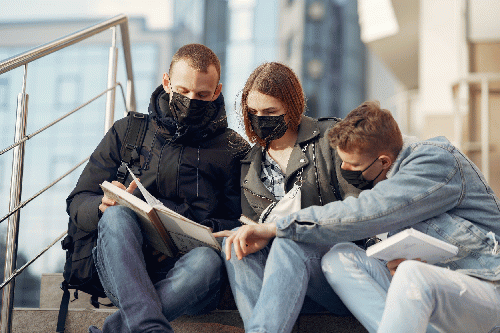Two new studies make this question much easier to answer than Hamlet's
dilemma. If we all wear face masks in public, that alone will go a long
way towards choking off the coronavirus pandemic.
Writing in the prestigious Proceedings of the Royal Academy A,
epidemiologist Richard Stutt and colleagues at the UK's Cambridge and
Greenwich universities modeled 18 months of the pandemic with different
levels of mask-wearing effectiveness.
Not surprisingly, the biggest impact on the virus came when 100 percent
of the population wore masks that were highly effective both in keeping
infected people from expelling virus-laden droplets and protecting
healthy people from inhaling them. The models showed that combination could push the infamous R-value--the number of infections a typical
infected person passes on--below 1, and so snuff out the pandemic.
Even more encouragingly, even if the masks were just slightly more than
50 percent effective, or if slightly more than 50 percent of the
population wore them, that crucial R value could be pushed below the
magic number 1.
Here's the striking bottom line of this study, assuming face masks that are 50 percent effective:
"We note that 100% facemask adoption without lock-down achieves a
greater reduction in the final size of epidemic, a lower 'total removed'
and a lower peak of active cases than lock-down without facemasks."
Let me repeat that. According to their models, if everyone wore face masks, that would be more effective in limiting the size and impact of the epidemic than a total lockdown.
If we compare the social and economic impacts of universal face
mask-wearing to a full-scale lockdown, there's no contest. Wearing a
face mask is a significant nuisance, but it allows most activities to
continue--as we see in many Asian countries where face masks are a
normal part of life. Lockdowns, as we've seen, are immensely
life-changing and economically devastating.
But that's just a model, a critic might point out. However, a separate research team, reporting in the equally prestigious Proceedings of the National Academy of Sciences,
analyzed the actual spread of the coronavirus in three of the worst-hit parts
of the world, Wuhan, China, Italy and New York City. The researchers
tracked the course of the epidemic in each location as different
measures were put in place to try to control it.
Their conclusion was striking--mandated face covering was ". . . the
determinant in shaping the trends of the pandemic." Renyi Zhang, at
Texas A&M Univeristy, and colleagues, calculated that face masks
alone prevented 78,000 COVID-19 cases in Italy between April 6 and May
9, and over 66,000 in New York between April 17 and May 9.
Based on the
percentage of diagnosed COVID-19 patients who died in Italy and New
York, wearing face masks likely saved more than 15,000 lives in Italy and New York City during those weeks.
This research team's bottom line:
"We conclude that wearing face masks in public corresponds to the
most effective means to prevent interhuman transmission, and this
inexpensive practice, in conjunction with simultaneous social
distancing, quarantine and contact tracing represents the most likely
fighting opportunity to stop the COVID-19 pandemic."
Again, note that wearing face masks in public, maintaining a safe
distance from others, quarantining people who are infected and tracing
their contacts, while challenging, are still far less damaging to normal
life and to the economy than full-scale lockdowns.
So, two separate studies using completely different methodologies came
to essentially the same conclusion. Wearing face masks in public can be
extremely effective in snuffing out this world-shaking pandemic.
I'm wearing my mask whenever I step out my front door. Please do all of the world a huge favor and wear yours too!





